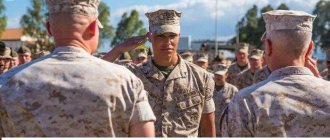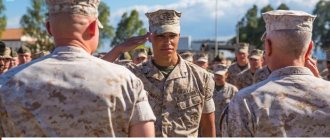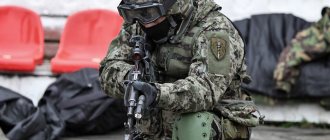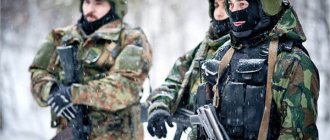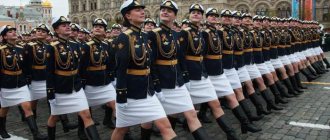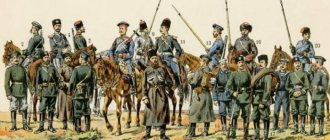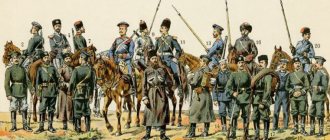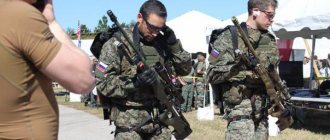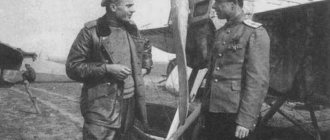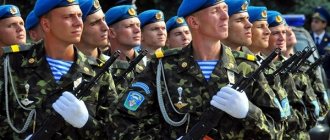New FSB form
It's no secret that one of the main distinguishing marks of various units of the Russian army is the uniform. After the collapse of the KGB and the creation of the FSB, by presidential decree it was changed to a state security unit. First, we need to talk about what requirements the new FSB uniform and more must meet in order to be accepted.
- Rank insignia are located symmetrically on the shoulders and stand out against the background of the main clothing.
- Strict style, made in one color, inserts of other shades can be used;
- Made from materials that are not stuffy to walk in all day long (summer), and so that you are comfortable and warm in the cold (winter);
- It should be comfortable and easy to wear, it should not squeeze anywhere or, on the contrary, sag;
Also, the new model FSB uniform is available in two types, casual and dress.
Special forces training and armament
It is quite difficult to get into special forces units, but not impossible.
First of all, the candidate must be in absolute physical health. It is not necessary to have impressive dimensions; endurance is much more important in special forces. During a raid, scouts can cover many tens of kilometers in a day, and they do it by no means lightly. You have to carry many kilograms of weapons, ammunition and ammunition.
The applicant needs to pass the required minimum: run three kilometers in 10 minutes, do 25 pull-ups, run a hundred meters in 12 seconds, 90 push-ups, do 90 abdominal exercises in 2 minutes. One of the physical standards is hand-to-hand combat.
Naturally, all candidates undergo the most thorough and scrupulous medical examination.
In addition to physical training, the psychological health of the applicant is no less important: a special forces soldier must be absolutely “stress-resistant” and not lose his head even in the most difficult situations. Therefore, candidates must undergo an interview with a psychologist, followed by a lie detector test. Moreover, the relevant authorities carefully check all the relatives of the future intelligence officer, and parents are required to provide written consent for their son to serve in the ranks of special forces.
If a person does end up in special forces, he will have to endure many months of hard training. Fighters are trained in hand-to-hand combat, which significantly enhances the spirit and strengthens character. A special forces soldier must be able to fight not only with his bare hands, but also use various different objects in battle, sometimes not at all intended for combat use.
The rookie is often placed against stronger opponents (and sometimes even several), in which case it is important for him not to defeat him, but to hold out as long as possible
From the very beginning of training, future special forces soldiers are instilled with the idea that they are the best.
Future special forces soldiers learn to endure the most severe tests that push a person to the brink of his physical capabilities: long-term deprivation of sleep, food, extreme physical activity, psychological pressure. Naturally, in special forces future fighters are trained to master all types of small arms.
Despite some specific tasks that the GRU special forces perform, its fighters most often use standard weapons of the Russian army.
Special forces are military special forces trained according to a special program and designed to carry out special combat goals and tasks. It is obvious that these units, among other things, must be the most mobile, maneuverable and resilient, and in this matter the fighter’s equipment plays an important role.
Special forces in full combat readiness
Reform and changes of the FSB in 2022
Summary According to the latest news, significant changes are expected in the Federal Security Service in 2022.
As a rule, for the first case, a more discreet look is used, and preference is given to convenience.
In particular, such as:
- FSO;
- SVR;
- PIL;
Changes in the FSB in 2022 are intended to significantly increase the degree of efficiency in managing the security forces of the Russian Federation, completely eradicate such a negative phenomenon as corruption, and also bring the country’s defense to a qualitatively new level. It is necessary to note the fact that preparations for the reorganization of the FSB next year were carried out successfully.
According to preliminary information, it is planned to include several additional units.
Structure and composition of the GRU Spetsnaz
According to available information, the GRU special forces currently include the following units:
- The 2nd separate special forces brigade is part of the Western Military District.
- The 3rd Guards Separate Brigade of the GRU (Central Military District) was created in 1966 in Tolyatti. However, there is information about its disbandment.
- 10th mountain separate brigade of the GRU of the North Caucasus Military District. It was formed in 2003 in the village of Molpino, Krasnodar Territory.
- 14th separate GRU brigade. Part of the Far Eastern District, it was formed in 1966. The soldiers of this unit took an active part in the fighting in Afghanistan. The 14th Brigade went through both Chechen campaigns.
- The 16th Special Forces Brigade is part of the Western Military District. Formed in 1963. She participated in both Chechen campaigns, in peacekeeping operations, and guarded particularly important facilities on the territory of Tajikistan in the early 90s.
- 22nd Guards Separate Special Purpose Brigade. It is part of the Southern Military District. It was formed in 1976 in Kazakhstan. She took an active part in the Afghan War. It is the first military unit to receive the rank of guards after the end of World War II.
- 24th separate GRU brigade. It is part of the Central Military District. The brigade took part in the Afghan War and in combat operations in the North Caucasus.
- 346th separate special forces brigade. Southern Military District, Prokhladny city. Kabardino-Balkaria.
- The 25th separate special forces regiment is part of the Southern Military District.
Also subordinate to the GRU there are four maritime reconnaissance points: in the Pacific, Black, Baltic and Northern fleets.
The total number of GRU special forces units is not known exactly. Various figures are cited: from six to fifteen thousand people.
Will the FSB reform take place in 2022?
After the 2022 presidential elections, the authorities discussed at least two options for reforming the FSB.
By order of the President of the Russian Federation, Vladimir Vladimirovich Putin, the so-called Russian Guard was created, which included the internal troops of Russia, as well as the vast majority of the state’s internal affairs forces.
Both involve the merger of several departments, including the FSB, into one large security structure.
Will the reform of the FSB begin in 2022 - the latest news on how the discussion of such prospects ended. Immediately after the presidential elections in the spring of 2022, the authorities discussed two different options for reform of the FSB. This is only what came out and became known to journalists. If one of the options is approved, FSB reform could begin as early as 2022.
The first option was informally called the “Russian FBI.”
We recommend reading: The receipt is written by the person receiving the monetary norm of right
He envisioned the emergence of a single investigative body, which would unite investigators from the FSB, the Ministry of Internal Affairs and the Investigative Committee.
It is not entirely clear why investigators from competing and balancing departments should be united under one roof. The most likely reason was the desire to save government costs on the investigation.
However, the idea had at least three serious flaws.
Criticism
Irina Borogan and Andrey Sodatov, who study the modern history of the country, in the book “The New Nobility: Essays on the History of the FSB,” published in 2011, note that employees included in the active reserve quite often “sat on two chairs.” Security leaders were confident that they remained committed to their service.
However, during the period of initial capital accumulation (1990s–2000s), such officers were often more loyal to the companies to which they were assigned, preferring their interests to those of the FSB. Sometimes the company was perceived by them as a boss. As for the security service ID, it only served as collateral, providing access to the necessary information and significant representatives of the FSB.
He also notes that quite a few attached to banks with a dubious reputation, at best, did not play any role, and at worst, they only caused harm. It got to the point that in some cases such employees found themselves embedded in corruption chains. As an example, the story of Chekalin, whose subordinates were seconded from banks, is given.
Reform of the FSB in 2022
in 2, Contents: What will happen to the FSB in 2022 and what other changes should employees and ordinary citizens expect? Today, the future fate of one of the main law enforcement agencies in Russia is under great question, despite the fact that this topic has been actively discussed in the media since 2016.
The Chairman of the Investigative Committee of the Russian Federation, Alexander Bastrykin, was on vacation for almost 2 months and celebrated his 65th birthday on August 27. Many were seriously alarmed by the absence of the chief FSB official: the media even talked about the possible liquidation of the Federal Security Service of Russia as a separate agency, and employees talked about total layoffs and other “adverse consequences.” Despite concerns, the chairman returned to duty early on September 11, although he was supposed to start work only at the end of October 2022.
Today the FSB operates in the “current mode”: no changes have been heard.
Order of the FSB of the Russian Federation dated August 27, 2010 N 413 “On military uniforms for military personnel of the federal security service” (with amendments and additions)
Order of the FSB of the Russian Federation dated August 27, 2010
N 413
“On military uniforms for military personnel of the federal security service”
July 21, 2014 In accordance with the President of the Russian Federation dated March 11, 2010
N 293 “On military uniforms, insignia of military personnel and departmental insignia” I order: 1. Approve: 1.1. Description of military uniform items for military personnel of the federal security service (). 1.2. Rules for wearing military uniforms, insignia and insignia by military personnel of the federal security service ().
2. The FSB of Russia dated March 31, 2008 shall be declared invalid.
N 130
“On military uniforms for military personnel of the federal security service”
(registered by the Ministry of Justice of Russia on April 14, 2008, registration No. 11530). Director A. Bortnikov ______________________________ * Collection of legislation of the Russian Federation, 2010, N 11, art.
1194.
Management
Since 1998, the head of the FSB TsSN is Colonel General, Hero of the Russian Federation Alexander Evgenievich Tikhonov. In 1996, he took the position of first deputy head of the Alpha Directorate, which was located in the Anti-Terrorism Center of the Federal Security Service. After 2 years, with the rank of Colonel General, Alexander Evgenievich headed the Special Purpose Center, which was formed on the basis of the Vympel and Alpha combat units.
Under the leadership of Tikhonov, the center carried out activities aimed at combating terrorism and eliminating militants in Chechnya. In 2003, for the courage shown during the operation, the president, by “closed decree,” awarded the colonel general the title of Hero of the Russian Federation. According to some reports, this decision was made due to effective actions during the release of hostages who were held in the Theater Center located on Dubrovka.
What will happen to the FSB in 2022
MonTueWeThuFriSatSun 123456789101112131415161718192021222324252627282930 Remaining until the end of 2022: Latest news
- Refinancing rate for 2022 by the Central Bank of the Russian FederationBMW X1 2022New rules for conscription into the army in 2022New rules for working in a taxi will come into force in 2022Elections to the Moscow City Duma in 2022Mercedes GLB 2022Asap Rocky concert in MoscowTeacher of the Year competition in 2022What will happen to the Internet in 2022 in RussiaBMW 1-series 2022 News 2022 12/19/2022 Share Twitter Facebook Contents 1 At the apparatus of power2 When to expect change3 What is happening in the security forces and what other changes should employees and ordinary citizens expect?
Today there is a big question
About seasonal clothing
Russian military personnel, including employees of the Russian Federal Security Service, need seasonal clothing. Therefore, when making new clothes, the climatic features of the country must be taken into account.
Thus, FSB officers can work both in the middle zone and in extremely cold regions of the country. In addition, they are also present in the hottest regions of the country, in deserts and semi-deserts. For this reason, the form is presented in several variations.
For example, there are special border suits for the Arctic regions. They can serve during any changes in the harsh polar climate.
The most difficult service in this regard is the service of the Coast Guard of the FSB of the Russian Federation. Their clothing has many additional features designed to protect people. In addition, the clothing provides for the possibility of an employee falling overboard. It is characterized by increased buoyancy just for this case.
When it comes to border guards at checkpoints, the most important thing for them is that the documentation is completed correctly. At the same time, they must have a neat appearance. Also, due to the fact that they are entrusted with the function of conducting inspections, their service requires increased physical activity. Sometimes it becomes necessary to look at aircraft landing gear, side trim, and car bumpers. Therefore, clothing of this type is practical.
The main element in clothing intended for northern areas is an electrically heated vest. Its most important function is to warm the employee, improve his well-being, relieve fatigue and stress. In just a couple of minutes, the human body begins to actively absorb the heat caused by the vest. The speed of recovery processes increases
It is important to note that the conclusions of the FS indicate that such radiation is completely safe for the human body. But you need to know that the vest has its own charge level
The degree of heating is displayed on a special indicator. The weight of the heating set is no more than 350 grams.
It can work for 6-24 hours, taking into account the degree of heating. In addition, special heating insoles were invented. They are also equipped with heating elements, and the battery from them is not attached to the shoes, since it is located directly in the insoles. Using a special remote control, the insoles are turned off or on. You can also regulate their temperature separately. How long the insoles last will also depend on how intensely they generate heat. At minimum settings they will last for 8-10 hours, if the heating level is medium they will last for 6-8 hours, and at maximum settings they will work for 4-5 hours.
Form of the FSB of Russia
There are several simple rules that should be followed in the process of creating a new sample of everyday uniform for an employee of the FSB of Russia.
Firstly, no contrasts, everything should be extremely monotonous. Secondly, every seam, every cut processing must be extremely precise.
Thirdly, the cut should be as correct and precise as possible.
This should only be done by a person who has extensive experience in the field of cutting and sewing.
It is also very important to remember that there simply cannot be any age restrictions for this type of clothing.
Well, it goes without saying that the new uniform of a Russian FSB officer should be extremely practical and comfortable.
Roughly speaking, it should be strictly official. The fabric from which the new uniform of the Russian FSB officer is made is of great importance. The most commonly used fabric is a mixed fabric made from natural and synthetic materials, since this type of fabric is considered the most wear-resistant and practical.
Rationale
In 2022, President Vladimir Putin signed a decree regulating the activities of Russian foreign intelligence officers who are not members of the cadre. That is, this document should streamline the situation with officers who are in the “active reserve” (seconded employees).
A law adopted in the 1990s regulating the work of the FSB allowed employees of this service to become seconded regardless of what form of ownership is present at a particular enterprise. This required the consent of its leadership. Such seconded FSB officers were registered as legal consultants.
After the law regulating private detective and security activities was passed in March 1992, and the government decree adopted in August of the same year, seconded security officers had the legal opportunity to use the technical resources of the KGB and the Ministry of Internal Affairs.
Uniform of FSB officers of Russia - features, history and reviews
Not long ago, a new uniform for FSB officers was introduced. The final decision was made in 2007. At the same time, a new and unusual color for the country for the uniform of FSB officers of Russia was introduced - blue-black.
The clothes were accompanied by a cap of the same shade. After this reform, many questions arose in society - what does this dark color of clothing mean for security officers?
Someone compared the new uniform of FSB officers with the attire of guardsmen and monks.
They also remembered Stirlitz’s uniforms.
An interesting fact is that the new form of the Federal Security Service in someone’s imagination echoed the description of the heroes of the Strugatsky brothers, the cavalry of the Holy Order. Someone said that this is an exotic way for the president to single out employees for the fact that Shamil Basayev was eliminated. However, then this version faded into the background.
The fact is that services are no longer mentioned everywhere as an achievement
The difference between the uniform of the GRU special forces and other branches of the military
Special forces developed with the Airborne Forces simultaneously and due to similar specifics and
The application and task profile of these troops, their uniforms were identical. The special forces soldiers wore exactly the same uniform as the paratroopers. Outwardly, it is very difficult to distinguish who is standing in front of you: a special forces soldier or an airborne soldier. After all, the color, the shape, and the cockade itself are the same. However, the GRU had one caveat.
In Soviet times, special forces soldiers primarily wore blue berets and airborne uniforms in training units or in parades. After the training centers, the soldiers were assigned to combat units, which could be carefully disguised as other types of troops. This was especially true for those who were sent to serve abroad.
Instead of a blue and white vest, beret and lace-up boots, the soldiers were given the usual combined arms uniform, for example, like tank crews or signalmen. So we could forget about berets. This was done in order to hide the presence of the special forces from the eyes of the enemy. Thus, for the GRU, the blue beret is a ceremonial headdress and only in those cases when it is allowed to be worn.
The GRU special forces beret is not just a type of headdress and an integral part of uniform, but a symbol of valor and courage, honor and nobility, the right to wear which is not given to everyone, even the most experienced and brave warrior
Losses
1984 Air accident Nikolaevka, 77th OPLAP of the Pacific Fleet Air Force. Takeoff emergency abort. The plane skidded off the runway, was damaged and was written off. The crew was not injured.
1984 Asmara Airfield, Ethiopia. As a result of the separatists' raid on the airfield, two Il-38s belonging to the 77th OPLAP of the Pacific Fleet Air Force were destroyed, the crews were not injured.
1994 Air disaster Severomorsk-1, 24th OPLAP SF Air Force. While landing in conditions of heavy snowfall and drifting snow, the plane deviated from the landing course and collided with the ground. The crew died.
2002 The crash of two Indian Il-38 aircraft at an air show, anti-submarine squadron INAS 315. 12 people were killed. To replace the crashed vehicles, Russia provided two Il-38s free of charge.
Activity
"Smerch" is engaged in the prevention, suppression, detection, disclosure and investigation of acts of terrorism. For this purpose, operational combat operations are carried out. According to Chapter 2 of Article 9.1 of the Federal Law “On the Federal Security Service” of 1995, April 3.
Over the 20 years of its existence, the FSB TsSN, independently or jointly with other units, successfully carried out a large number of operational search operations, during which they managed to seize a lot of weapons, ammunition, explosive devices from criminal organizations, as well as free hundreds of hostages, neutralize gang formations and deal with dangerous leaders, including:
- Salman Raduev.
- Aslan Maskhadov.
- Arbi Barayev.
- Anzor Astemirov.
- Rappani Khalilov.
Among those detained and eliminated are emissaries of the world-famous terrorist group Al-Qaeda. During the work of the TsSN FSB of the Russian Federation, employees were awarded state awards more than 2000 times, while 20 servicemen were awarded the title “Hero of Russia”, but 11 were received posthumously.
About seasonal clothing
Russian military personnel, including employees of the Russian Federal Security Service, need seasonal clothing. Therefore, when making new clothes, the climatic features of the country must be taken into account.
Thus, FSB officers can work both in the middle zone and in extremely cold regions of the country. In addition, they are also present in the hottest regions of the country, in deserts and semi-deserts. For this reason, the form is presented in several variations.
For example, there are special border suits for the Arctic regions. They can serve during any changes in the harsh polar climate.
The most difficult service in this regard is the service of the Coast Guard of the FSB of the Russian Federation. Their clothing has many additional features designed to protect people. In addition, the clothing provides for the possibility of an employee falling overboard. It is characterized by increased buoyancy just for this case.
When it comes to border guards at checkpoints, the most important thing for them is that the documentation is completed correctly. At the same time, they must have a neat appearance. Also, due to the fact that they are entrusted with the function of conducting inspections, their service requires increased physical activity. Sometimes it becomes necessary to look at aircraft landing gear, side trim, and car bumpers. Therefore, clothing of this type is practical.
The main element in clothing intended for northern areas is an electrically heated vest. Its most important function is to warm the employee, improve his well-being, relieve fatigue and stress. In just a couple of minutes, the human body begins to actively absorb the heat caused by the vest. The speed of recovery processes increases
It is important to note that the conclusions of the FS indicate that such radiation is completely safe for the human body. But you need to know that the vest has its own charge level
The degree of heating is displayed on a special indicator. The weight of the heating set is no more than 350 grams.
It can work for 6-24 hours, taking into account the degree of heating. In addition, special heating insoles were invented. They are also equipped with heating elements, and the battery from them is not attached to the shoes, since it is located directly in the insoles. Using a special remote control, the insoles are turned off or on. You can also regulate their temperature separately. How long the insoles last will also depend on how intensely they generate heat. At minimum settings they will last for 8-10 hours, if the heating level is medium they will last for 6-8 hours, and at maximum settings they will work for 4-5 hours.
Appendix No. 2. Rules for wearing insignia and other signs by military personnel
On the neck ribbon are worn: the badge of the Order of St. George, II and III degrees; awarded the Orders of St. George and “For Services to the Fatherland”, intended to be worn on a neck ribbon, they are arranged from top to bottom in order of seniority.5. Belt with belt loops. 49. Shirt. Blue (cream, white) shirt. Consists of shelves, back, belt, collar and long (short) sleeves.
On the left side of the chest are worn: - above orders and medals, insignia of special distinction: the “Gold Star” medal of the Hero of the Russian Federation; the gold medal “Hero of Labor of the Russian Federation”; the “Gold Star” medal of the Hero of the Soviet Union; the gold medal “Hammer and Sickle” of the Hero Socialist Labor; badge of the Order "Mother Heroine"; - in front of other orders and medals: badge of the Order of St. George, IV degree; badge of the Order of Merit for the Fatherland, IV degree; badge of the Order of Alexander Nevsky; badge of the Order of Suvorov; badge
Woolen cap. A woolen cap of blue-black (black, light green) color consists of a bottom, crown, band and visor. The bottom, crown are blue-black (black, light green) color, the band is cornflower blue (black).
Along the edge of the bottom and the upper edge of the band of the cap there are cornflower blue (white) edgings. On the lower edge of the band of the woolen cap of black color there is a black tucked edging for a black ribbon put on the band. On the front, in the center of the band of the woolen cap, there is a cockade (for senior officers - sewing). The bottom, crown (walls) are made of woolen fabric, the band is made of cutlery cloth. In border agencies and military educational institutions with a border profile: the bottom, crown, and band are made of instrument cloth. Above the visor, along the band, for officers, a braided cord of golden color is fastened, which forms two loops at the ends using belt loops
Cheka
The Soviet secret services began with the famous Cheka - the All-Russian Extraordinary Commission, the “Chekyka”, which is why secret service employees are still sometimes called security officers.
The All-Russian Extraordinary Commission to Combat Counter-Revolution and Sabotage under the Council of People's Commissars of the RSFSR was created in December 1917 as an organ of the “dictatorship of the proletariat” to combat counter-revolution. The Cheka was headed by one of Lenin’s closest associates, Felix Dzerzhinsky.
After the end of the Civil War, the abolition of the so-called “war communism” and the transition to the “new economic policy” (NEP), the Cheka was reorganized into the GPU (State Political Administration), and then - after the formation of the USSR - all republican GPUs became part of the OGPU (United State Political Administration).
From the history of self-propelled guns
The definition of self-propelled artillery is more than simple. This is a combat vehicle, which is an artillery gun mounted on a self-propelled chassis and intended for fire support of infantry and tank troops in battle.
Some sources used the exclusion method, indicating that self-propelled guns are all armored combat self-propelled artillery units (Gvozdika included) with guns, except for tanks, armored personnel carriers, infantry fighting vehicles and infantry fighting vehicles.
Despite the fact that 2S1 artillery as a type of weapon has existed since time immemorial, and attempts to make systems self-propelled began simultaneously with the development of the first tanks, the history of self-propelled guns is much more modest than the path that armored vehicles have taken in their development:
- the years of the First World War - ongoing attempts to install artillery systems on some kind of self-propelled chassis, using, for example, trucks or agricultural tractors;
- 1915-1917 – the emergence of individual self-propelled gun developments: 75 mm Krupp guns, British self-propelled guns with a 60-foot gun, French Schumann armored carriage (57 mm), Mendeleev’s tank (the son of the great chemist);
- 30s - in the USSR, on the basis of unsuccessful models of heavy tanks T-35 and T-28, the first self-propelled guns SU-14 and self-propelled guns for direct infantry support were created based on the light tank T-26 and the T-27 wedge;
Self-propelled artillery unit SU-100
- years of the Great Patriotic War - several variants of self-propelled guns were created: the ZIS-30 self-propelled gun, the SU-122 assault gun, the universal (as opposed to the German specialized) ISU-152 and SU-100 vehicles, which remained in service with the Soviet army for another two decades after the war .
- 60s -70s - after several years of struggle between cannon artillery and missile systems, a decision was made to create self-propelled howitzers;
- July 1967 - by government decision, Sverdlovsky began developing the artillery part of a self-propelled 122-mm howitzer, while at the Kharkov Tractor Plant, work began on creating a chassis for a new combat vehicle based on the MT-LB tractor;
- August 1969 - four self-propelled howitzers were presented for testing;
- 1970 – a new combat vehicle called the 122-mm self-propelled howitzer 2S1 “Gvozdika” was put into service.
Serial production of 2S1 was carried out at KhTZ from 1970 to 1991. During this time, more than 10 thousand self-propelled guns were produced. "Gvozdika" was exported to more than two dozen countries and is now in service with the Russian army.
122-mm self-propelled howitzer "Gvozdika"
Along with the production of self-propelled guns at Soviet factories, the production of Gvozdika was established in Poland, Bulgaria, Romania, and Iran. Foreign manufacturers made some adjustments to the base model, but they did not change the main technical characteristics of the Gvozdika self-propelled gun.
About the initiative
You may be interested in: At what age can you rent an apartment: legislative norms
The initiative to introduce a new form of the FSB of the Russian Federation came from the state security services themselves. It was they who supported the presidential decree. Initially, it was proposed that special services specialists wear uniforms identical to those of the army.
The styles had to be the same. Moreover, the employees of these bodies were military personnel by status. The uniform is not required for civilians.
The special uniform of FSB employees aims to emphasize the privileged position of employees. It also sets them apart from other military personnel.
